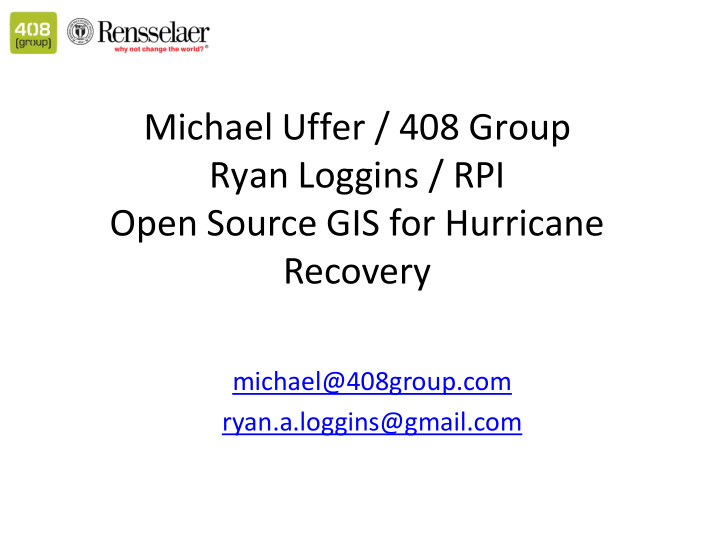



Michael Uffer / 408 Group Ryan Loggins / RPI Open Source GIS for Hurricane Recovery michael@408group.com ryan.a.loggins@gmail.com
The MUNICIPAL Project Multi-Network Interdependent Critical Infrastructure Program for the Analysis of Lifelines • A decision-support tool developed for the U.S. Department of Homeland Security (DHS) Coastal Hazards Center. • Designed to aid in the restoration of critical infrastructure systems following storm events. • Predicts damage to infrastructure components given a specific disaster scenario, • Developed and tested in close cooperation with the New Hanover County, North Carolina Department of Emergency Management. • Comprises a web based GIS visualization tool which is used to verify research results and train Emergency Managers in disaster recovery.
Users and Use Cases • The primary end user for this technology is local emergency management organizations – Training, drills, and exercises – Preparation for an imminent event – What-if? Analysis – Others potential users include infrastructure managers and designers • Two datasets are currently being used – New Hanover County, NC dataset is being used to validate models and prove the technology – “Clarc County” artificial dataset is used to share the technology with potential users
The Models Network Disruption Model Infrastructure Dataset Damage Restoration Assessment Model Model
Interdependent Infrastructure Systems Transportation Water Communications Power
Demo – Damage Simulaton
Demo – See Connections
Demo – Text and Map Connections
Demo – Restoration Gantt Chart
“Clarc” County Artificial Dataset
The Collaboration • RPI • Department of Homeland Security • New Hanover County, NC • UNC Chapel Hill • 408 Group • Sandia National Laboratory
Why Use Open Source GIS? • Flexibility • Mix and match best of breed parts for each element. Database, display, user interaction, analysis, security • Most tools and components interoperate • Large community of users, blogs, support forums • Cost • Reduces cost of software and may enable projects with lower budget. Software license may be a large part of projects budget. • Cuts out time to acquire commercial software. May be a large part of the project timeline, especially in government applications. • Meets technical requirements of many projects • Ability to generate maps in an interactive online interface. • Incorporate latest client features: interactive zoom, pan, layer manager • Interoperability with dynamic data source or RDBMS. • Interoperates with existing packages such as ESRI ArcMap, Arc GIS Server • Maturity • Many components have 10 year history of development and enhancements .
GIS Software Stack or Framework • Geo Server - Drawing and Rasterizing Engine • Client Side – Open Layers GIS/Javascript Framework – jQuery – AJAX framework for UI interaction – HTML 5 controls – Google Maps base layer • Spatial Databases – Postgis – Geo Enabled Postgres relational database • PHP programming language on Server • REST interfaces for all server side data. • Data conversion tools such as OGR2OGR – to translate from ARCMap to Postgis
References and Links Modeling Methodology • B. Cavdaroglu, E. Hammel, J. E. Mitchell, T. C. Sharkey, and W. A. Wallace, “Integrating Restoration and Scheduling Decisions for Disrupted Interdependent Infrastructure Systems,” Annals of Operations Research, March 2013, Vol. 203, Issue 1, pp 279-294 Model Integration • R. Loggins, W. Wallace, and B. Cavdaroglu, “MUNICIPAL : A Decision Technology for the Restoration of Critical Infrastructures,” Proceedings of the Industrial and Systems Engineering Research Conference , May 2013
References and Links (continued) • GeoServer - geoserver.org • Postgis Project - postgis.net/ • Open Layers Project openlayers.org/ • Open Geo Application Stack - boundlessgeo.com/solutions/opengeo-suite/ • jQuery Javascript Framework - jquery.com/ • OGR Tools www.gdal.org/ • 408Group – www.408group.com
A sample of other 408 Group GIS Projects • NYC Deptartment of City Planning - Parking Information for the Mobile Web – Expose Parking lot data sets to citizens and other government agencies – Reduce Traffic Congestion by allowing users to more easily locate parking • NYC Department of Finance – Mobile Property Tax Assessment – Automate Tasks – Create more consistent processes for determining assessments • NYC Department of Homeless Services - The Homeless Census – Better organize effort. Pre defined instructions and tasks – Better compliance with government counting requirements.
Recommend
More recommend